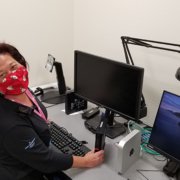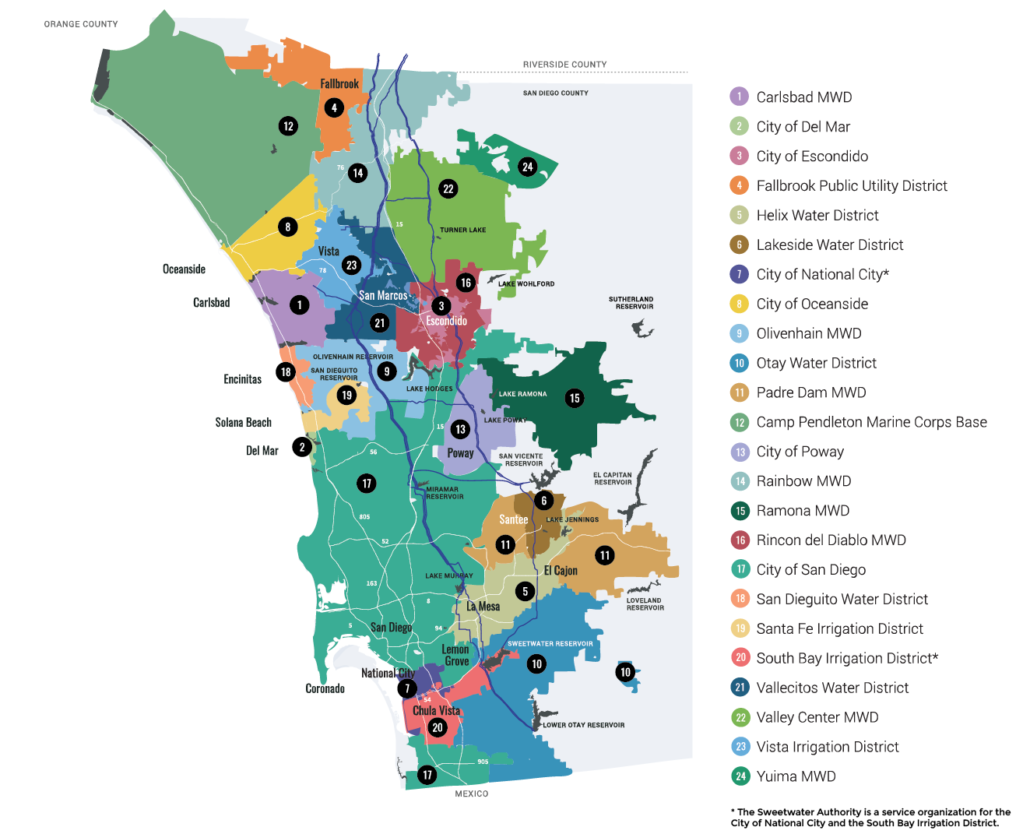All three major rating agencies – S&P, Moody’s, and Fitch – have affirmed the San Diego County Water Authority’s strong credit ratings, which will help the Water Authority optimize its debt portfolio and minimize the cost of financing important water reliability projects.
The reports cited the Water Authority’s strategic management, its conservative approach to water sales projections, and the benefits of the Water Authority’s rate case litigation that recently resulted in $44.4 million being refunded to local retail water agencies – among many other factors.
Significant challenges
However, rating agencies also noted significant challenges ahead, including efforts by Fallbrook Public Utility District and the Rainbow Municipal Water District to “detach” from the Water Authority – a move that could negatively impact ratepayers across San Diego County. If the two North County agencies leave per their plans, Water Authority analysis shows that the other 22 member agencies will have to pay $16 million to $46 million more per year to cover the cost of the departing agencies.
Moody’s said detachment could lead to a credit downgrade, which would increase borrowing costs for critical water reliability projects. S&P Global called detachment uncertainty “an additional credit stressor” – “especially if an approved detachment sets a precedent if members can easily detach from the authority.” S&P added that, “this would be further exacerbated if the two members are not required to pay for their portion of the associated debt and infrastructure costs that the authority has undertaken to provide reliable water sources.”
Solid financial position
Water Authority General Manager Sandra L. Kerl said, “The Water Authority maintains a solid financial position even in these difficult times, and the credit ratings reflect that. But the challenges are real as well, and they should unify the region to ensure that we continue to benefit from the safe, reliable water supplies we’ve invested in together for the past 30 years.”
In affirming their credit ratings, the services cited the Water Authority’s strong financial leadership, including prudent strategies to manage issues related to COVID-19, its success diversifying water supply sources, its commitment to infrastructure maintenance, and its financial reserves for managing contingencies, among other factors.
- Fitch Ratings affirmed its AA+ rating and gave a stable outlook on March 15. Fitch noted the Water Authority’s “operating costs are low” and credited the Water Authority for “significant investments in supply diversification (that) have allowed SDCWA to continue to meet water demands in its service area.” Fitch also accounted for the Water Authority’s current hiring freeze, spending cuts and deferral of $30 million in planned capital spending to proactively manage finances during the pandemic.
- Moody’s Investors Service affirmed its Aa2 rating and stable outlook March 14. Moody’s said, “the stable outlook reflects our expectation that the Authority’s satisfactory operating performance will continue, supported by strong management practices in the face of challenges associated with variable water supplies, rising costs, and the coronavirus pandemic.” Moody’s added: “Liquidity, including a rate stabilization fund, remains sound serving to insulate the Authority from risks associated with variable water supplies, including California’s (Aa2 stable) current drought conditions, as well as unanticipated events such as the coronavirus pandemic.”
- S&P affirmed its AAA rating on March 17 and issued a negative outlook based on “heightened business risks associated with potential projected declines in water sales.” On the plus side, S&P cited the Water Authority’s demonstrated ability to navigate highly variable demands and weather cycles. The agency also said, “management is taking important steps” to balance fixed and variable costs, and it praised the Water Authority’s “robust infrastructure maintenance and operational policies.”
Risks include detachment
All three agencies addressed risks, such as additional local supplies that reduce Water Authority sales and member agency detachment. As proposed by Fallbrook and Rainbow, the detachments would allow those agencies to avoid paying for water supplies and infrastructure that have been developed in collaboration with those agencies and are currently being used by those agencies to meet their customers’ needs. Abandoning those cost obligations would force other ratepayers countywide to cover their portion of the bills already incurred for decades of investments in supply reliability.
In May 2020, the Water Authority’s Board of Directors voted to oppose detachment unless four conditions can be met related to protecting Fallbrook and Rainbow ratepayers, avoiding negative impacts for other member agencies, protecting the Sacramento-San Joaquin Bay-Delta, and maintaining the Water Authority’s voting rights at MWD.
The issue is under review by the San Diego Local Agency Formation Commission, known as LAFCO. The LAFCO process, which is designed to provide for an impartial analysis of these issues, will allow the Water Authority and all other affected parties to determine if these conditions are satisfied. If not, the Water Authority will oppose detachment.
For more information about the Water Authority’s finances go to: www.sdcwa.org/finance-investor-relations. Information about detachment is at https://www.sdcwa.org/member-agencies/lafco-reorganization/.

 Sweetwater Authority Logo 2019
Sweetwater Authority Logo 2019




